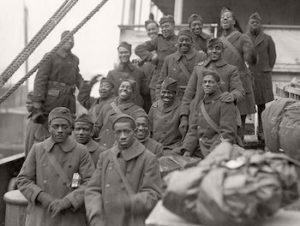
*The Harlem Hellfighters were commissioned on this date in 1913. They were an all-Black WWI 369th Infantry Regiment of the U.S. Army.
They were a New York Army National Guard unit in the 15th New York Infantry Regiment. The Hell Fighters were assembled on June 29 that year and called into Federal service on July 25, 1917, at Camp Whitman, New York. While at Camp Whitman, the 369th Infantry learned basic military practices. These basics included military courtesy, how to address officers, and how to salute. They also learned to stay low and out of sight during attacks, stand guard, and march in formation.
After training at Camp Whitman, the 369th was called into active duty in New York. While there, it was split into three battalions, which guarded rail lines, construction sites, and other camps throughout the state. On October 8, 1917, the Regiment traveled to Camp Wadsworth in Spartanburg, South Carolina, where it received combat training similar to that received on the French battlefields.
While at Camp Wadsworth, they experienced significant racism from the local communities and other units. There was one incident where two soldiers from the 15th Regiment, Lieutenant James Reese Europe and Noble Sissle, attempted to buy a newspaper. Several soldiers from the white 27th Division came to aid their fellow soldiers. Lieutenant Europe had commanded them to leave before violence erupted. Many other shops refused to sell goods to the members of the 15th Regiment, so members of the 27th and 71st Divisions told the shop owners that if they did not serve black soldiers, they could close their stores and leave town. The white soldiers stated, "They're our buddies, and we won't buy from men who mistreat them."
Before the 369th’s assignment to work directly under the French, General Pershing warned the French military in a pamphlet entitled: “Secret Information Concerning the Black American Troops.” The directive essentially warns the French that if they worked too closely or too well with the members of the 369th, then white Americans would hold it against them. “The increasing number of Negroes in the United States (about 15,000,000) would create for the white race in the Republic a menace of degeneracy were it not that an impassable gulf has been made between them.” Later, the booklet stated: “Although the white American regards a citizen of the United States, the black man as an inferior being …” Pershing booklet was ignored by the French, who were used to fighting alongside colonists of other colors from other countries), the men of the 369th were out dedicating themselves to doing their part to win the war.
They became known for their fearsome fighting and proved their endurance: They fought from the trenches for 191 days longer than any other American unit. None of their soldiers were ever captured, though they eventually lost about half the Regiment (1500 losses) toward the war's end. Ultimately, their war record showed a unit that consistently went above and beyond to fight for the Allies. After the war, the French Army acknowledged its fine work. The Regiment was awarded the Croix de Guerre, the highest honor given by the French. There were also 171 individual medals awarded to members of the 369th. The unit Regiment Marching Band was commanded by Lieutenant Europe, one of the best-known jazz bandleaders in the U.S. He and the military band are said to have introduced jazz to the Allies.
The 369th was the first Regiment to return to the United States, so they were the first to be honored by a parade. The festivities began early on the morning of February 17, 1919. The Harlem Hellfighters paraded Fifth Avenue from 23rd Street to 145th Street and Lenox Avenue. The schools in Harlem were dismissed for the day so students could be on hand to welcome the soldiers home. At the parade’s conclusion, the men, followed by family and friends, loaded up subway car after subway car to travel to the 34th Street Armory, where the celebration continued. But this parade was to be the only one in which they were included. When a Victory Parade was held for the entire military in later months, the Harlem Hellfighters were not permitted to participate.
After World War I, they were absorbed into the National Guard. The 15th Infantry Regiment, NYARNG, was assigned on December 1, 1917, to the 185th Infantry Brigade. It was commanded by Col. William Hayward, a member of the Union League Club of New York, which sponsored the 369th in the tradition of the 20th U.S. Colored Infantry, which the club had sponsored in the Civil War. The 15th Infantry Regiment shipped out from the New York Port of Embarkation on December 27, 1917, and joined its brigade upon arrival in France. The unit was relegated to labor service duties instead of combat training. The 185th Infantry Brigade was assigned on January 5, 1918, to the 93rd Division. The 15th Infantry Regiment, NYARNG, was reorganized and redesignated on March 1, 1918, as the 369th Infantry Regiment. Still, the unit continued labor service duties while awaiting a decision about its future.
The unit survives today as the 369th Support Battalion of the New York Army National Guard.